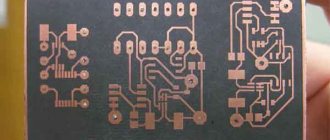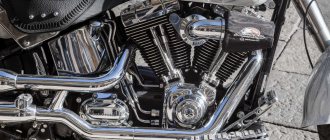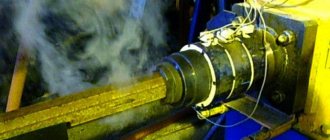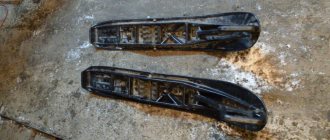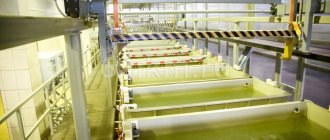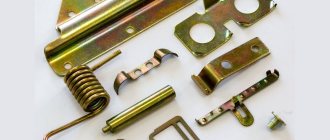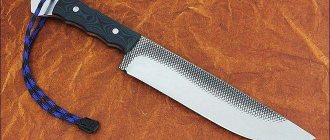Galvanics is also a branch of applied science “Electrochemistry”, which studies the processes that occur during the deposition of metal cations on a cathode placed in an electrolytic solution, and the technological process. Electroplating at home or performed in production allows you to apply a thin layer of metal to the surface of the workpiece, which can act as a protective or decorative coating.
Methods for implementing such a technological process, which is quite complex, have already been well developed, so today it is actively used not only by manufacturing enterprises, but also by many home craftsmen.
General idea of electroplating
Galvanic coating can be either technological or decorative-protective. It is a thin surface layer of metal that has a good aesthetic appearance (gold, silver) or anti-corrosion properties (zinc, copper) on metal or plastic products.
In general terms, metal electroplating at home looks easy.
This is interesting: Features of welding aluminum with an inverter at home
Galvanoplasty and galvanostegy
What is galvanoplasty? This is a method that is used to make exact copies of products, the copying method. It is used when it is necessary to make a copy of objects of the finest configuration - records, chips and circuits. Electroplating allows you to enhance the mechanical properties of one metal by applying a layer of another metal to it, for example, chrome and nickel plating of steel, nickel plating of copper, etc.
Galvanoplasty and galvanostegy are of a similar nature, differing only in the method of preparing the metal before processing. When performing electroplating, the metal surface must be as prepared as possible for adhesion to the applied metal. The electroplating method, on the contrary, involves the free separation of the applied metal.
Copper, nickel and silver are most often used for electroplating processes, and almost all types of metals are used in electroplating processes. Home electroplating is performed using the same equipment as other electroplating processes.
A large glass container is perfect for a galvanoplastic bath. Its dimensions depend on the size of the item being galvanized, since it should not be located too close to the anode plate.
Electroforming at home can be used to make copies of small-sized objects using molds pre-cast from low-melting metals.
Master class on galvanizing (1 video)
Items with galvanic coating (17 photos)
Electroplating equipment
At home, you can make the equipment yourself. First of all, you need a power source, since the process occurs under the influence of electric current. In terms of current strength, home craftsmen differ, calling them in a very wide range. But a prerequisite is the presence of a voltage regulator to smoothly change the output power. The current must be constant, so the source is called a home-made or factory-made rectifier.
Craftsmen adapt a welding machine for electroplating at home.
The electrolyte requires a container (tub) made of a chemically neutral material. This can be a glass or plastic vessel of sufficient size to accommodate the part and the required amount of electrolyte for processing. It must withstand high temperatures, up to 80 °C, and be strong enough.
We also need anodes, the area of which should be larger than the area of the part. They serve to supply electric current to the electrolyte and distribute it evenly throughout the part. In addition, they must, in the electrolyte, compensate for the loss of metal that is released when coating products, and carry out some oxidative processes.
It is better to use heating devices for bringing the electrolyte to the desired temperature with the ability to regulate thermal conditions. For example, a household gas stove is not suitable for this purpose. Usually they use a small electric stove and an iron, in which you can set the required sole temperature.
Equipment for preparing electrolyte
To store chemical reagents and electrolytes, you need glass containers with ground-in lids.
To prepare electrolytes, the necessary substances must be measured to the nearest gram. For this you need appropriate scales. You can purchase them or make them yourself, using Soviet coins as weights, the denomination of which exactly corresponds to the mass.
Electroplating at home also means preparing an electrolyte from chemical reagents obtained through difficult means. Specialized companies selling such high-quality substances are not uncommon, but their activities are controlled, and working with them requires special permits, even for legal entities. Hazardous chemicals are not sold to private individuals.
What is needed to prepare electrolyte?
How to make electrolyte at home? First, let's choose the right container for storage: it should be a container made of an inactive substance (glass or plastic), durable, and tightly closed with a lid to prevent oxygen from entering the electrolyte.
Advice! A do-it-yourself electroplating rectifier can easily be made from a regular car battery.
Chemistry is an exact science. Each substance used will have to be measured to the nearest hundredth of a gram. You will need high-quality weighing equipment, preferably electronic. If there is no opportunity or desire to buy scales, take small change from the Soviet period; coins then had an accurate weight.
The most difficult thing for an ordinary citizen to obtain is the acquisition of reagents for the production of electrolyte. Many substances are prohibited for sale to individuals, only to industrial enterprises with special permission. Dangerous reagents will not be sold to ordinary people!
On video: Current 60A at home or homemade electroplating.
Process technology
Electrolytes are substances that can release ions – charged particles – under the influence of an electric current. This is what the principle of galvanization is based on. In our case, chromic anhydride will be used as an electrolyte. Released particles that will be deposited on the workpiece, forming a film - chromium molecules.
To chrome a part at home, it must be immersed in a bath of solution and connected to the negative wire. The positive anode is immersed in the electrolyte. Under the influence of current, the molecules in the electrolyte will begin to move. Positively charged to the minus (cathode), negative - to the plus. Moreover, some of the molecules form a film, and some will penetrate into the top layer, as a result of which chromium is firmly fixed on the surface. This makes galvanizing significantly different from conventional painting.
In a similar way, not only chrome plating is carried out, but also nickel plating, coating of products with copper and zinc. The processing principle will be the same in any case. The thickness of the spraying will depend on the current strength, heating temperature, processing time, and type of metal.
It is also possible to carry out chemical chrome plating at home. No special equipment is required here. The formation of a metal film on the surface in this case occurs due to chemical reactions in which sodium hypophosphite serves as a reagent. But such a coating is less durable - it is used only for decorative purposes.
This is interesting: How to cook stainless steel semi-automatically in a carbon dioxide environment: video, tips
Patination and oxidation of brass products
Products made of brass are also subjected to oxidation in order to paint the surface or create artistic compositions in an antique style. On brass products, oxide films with many colors and shades are obtained - yellow, orange, red, blue, black, etc., and it is possible to obtain both a glossy and matte surface.
Blackening of brass
One of the methods for blackening brass is a method in which antimony chloride is applied to the surface of the product. The reagent is applied with a brush or roller, and then rubbed in with a thick cloth or brush. Depending on the concentration of the solution, shades from gray to black are obtained.
Obtaining colored oxide films on brass
Colored oxide films on brass are produced in several ways. The simplest is oxidation in a solution of nitric acid. A brass part immersed in a solution is coated with a layer of copper nitrate and painted green-blue. The process occurs with gradual heating. The color of the film changes during the heating process, and the process ends with the surface being painted black.
As an oxidation solution, you can use a regular photo printing fixer (sodium triosulfate or hyposulfite). A small amount of nitric acid is added to the fixer solution (40-60 g/l) (the solution is acidified). As a result, a chemical reaction occurs with the release of sulfur dioxide and the deposition of sulfur, and the solution becomes cloudy yellow or yellow-green. Prepare the solution immediately before processing brass; the solution is active for 15-20 minutes. The color changes with exposure time and has a bluish or purple tint. The container for the solution is selected so that the surface of the product is visible. The product is immersed in a container for a short time, then removed and washed in hot water. Then a layer of sand is applied to the surface of the product and wiped with a brush or thick cloth. The product acquires its final shade after repeated immersion in the solution. After removal from the solution, the surface is treated with pumice, erasing the dark coating, dried and covered with a layer of transparent varnish.
Another method of color oxidation of brass is carried out in a solution of sodium thiosulfate (130-150 g/l) and acetic or lead nitrate (35-40 g/l). The solution is heated to 80-900C. The process requires constant visual monitoring, because the color of the film changes quickly and continuously - yellow, red, purple, blue and, at the end of the process, black. When the desired shade is obtained, the product is quickly removed from the container, washed and dried.
For all of the listed methods of brass oxidation, the general rule is valid - the reaction can be stopped at any stage of the process; when the desired shade is obtained, the product is removed from the solution. If the product is preheated, the reaction can be interrupted by stopping the heating. The shade is fixed by simply rinsing the surface with water. Lightening of individual areas of the product is carried out with gasoline.
There are no exact recipes for preparing oxidation solutions and process modes; the results of artistic color oxidation depend on many factors - the purity of the initial components, the degree of heating of the part or solution, and the method of processing the product at the end of the process.
Most of the listed methods for oxidizing and patination of silver, copper or brass can be carried out at home or in a garage workshop, subject to basic safety rules that are valid for any process of applying electroplating or chemical coatings where concentrated acids are used or an active solution is heated to release gaseous substances.
You may be interested in the following articles:
|
Required Equipment
Electroplating (chrome plating) at home is possible if you have the following type of equipment:
- power supply: it should show 1A at the output and be equipped with a voltage regulator; for small volumes of work, a current rectifier is sufficient; the wiring cross-section depends on the size of the workpiece (minimum 6.25 mm);
- wires: the positive one will be immersed in the electrolyte, the negative one, with an alligator holder, will be located at the end towards the workpiece;
- anodes made of tin, lead or antimony alloys;
- containers of suitable size made of chemically resistant, non-conductive material; the ideal option is a plastic bath; for chrome plating of small parts, a glass jar is sufficient;
- a wooden box with thermal insulation made of glass or mineral wool in which the container will be placed; Ordinary sand can also be used as insulation;
- sealed lid: it can be made from a piece of plywood or wooden boards;
- heating element, the power of which is sufficient to heat the liquid in the selected container to a temperature of 60-80°C;
- contact thermometer or thermostat;
- a hollow mold for pouring electrolyte with a tap or brush at the end; to make it, a bundle of copper wire is used, secured and tied with lead wire.
Features of the independent procedure
In order to correctly and reliably carry out the process of applying chromium with your own hands, you should take into account all the characteristic features of the chemical and physiological transformations that are taking place. Most of the chemical elements involved in chrome plating are represented by particularly dangerous elements, therefore, before starting experiments with chrome coatings, it is necessary to carefully study the theoretical side of the process.
Chrome gives the surface a remarkable appearance, thanks to which the product takes on a very elegant appearance. Electroplating opens up great opportunities for improving the decorative, physiological and chemical qualities of materials. Chrome is extremely resistant to aggressive environments, it does not darken under the influence of the environment, thanks to which it has found wide application in the design of car body parts and parts of elements operating in difficult conditions. The thickness of the shiny coating is very small: from 0.075 to 0.25 millimeters.
Unlike nickel, in most cases chromium is not used as a metal. For this, a light layer of galvanization is used. This kind of layer consists of copper and requires the use of technological influences, complicating an already difficult process.
Another problem that can stop you from completing the task is obtaining reagents. The main component is a chromium compound (CrO3), also known as chromium anhydride. An unpleasant feature of its use is that chromium oxide is the most powerful poison, the lethal dose of which is 6 g. This compound has a small turnover, which is strictly controlled by the state.
Residues resulting from the completion of chrome plating must be disposed of in accordance with a special procedure, and not enter the sewer or soil. The element is a strong carcinogen: if it appears on the skin, there will be very severe irritation, including eczema and dermatitis, and a tumor may form.
Industrial world
Copper is a fairly expensive metal. Therefore, the industry uses an alloy of copper and zinc called brass. Zinc content can range from 10 to 42%. This metal is stronger and has high conductivity. Classification. 1. alpha brass, (alpha + beta) - materials that are ductile in any state and beta brass - materials that are ductile in a hot state. 2. double (simple), which contain 88 - 97% Cu are called tombacs; those that contain 79 - 86% Cu are called semi-tompaks. 3. copper-zinc alloys, with inserts of one or more elements, are called special brasses. They are named by their dominant element: brass with lead is called lead. 4. simple ones are designated by the letter “L”, after which the percentage of copper content is indicated. Next comes the capital letter of the dominant element, and then the content of the entered elements as a percentage is indicated through a dash. Application. Marine (CZ112) - used in the equipment of pre-war boats. Corrosion-resistant (CZ132) - water intake and pipe fittings. High-strength (CZ114) - rigging shackles, propellers, winches. Regular (CZ108) - used in internal equipment. Including in mechanical engineering, it is used as screws in the internal structure, but not in the main parts. In medicine, brass and graphite electrodes are used. On such a metal surface, pathogens practically do not linger, and the copper included in its composition has a slight bactericidal effect. In electroplating, the following are mainly used: copper-zinc elements, carbon-zinc elements, alkaline elements (MnO2 anode and zinc cathode), mercury (cathode is a mixture of zinc and mercury), silver (cathode), lithium (anode) elements. Brass is not used as an electrode. This alloy is used in electroplating only for brass plating as a brass plate. Products coated with this alloy are connected to the negative pole of the current source of the galvanic cell, and the positive pole is connected to the brass plate. Brass plating is the application of a layer of brass several microns thick (approximate composition: 70% copper and 30% zinc) to the outer surface of metal (mainly steel) products. Protective and decorative finishing is also used when processing coins and is used to protect products from corrosion. Brass plating is used to improve the properties of titanium and to coat steel parts to be covered with rubber. This coating improves the adhesion of rubber to steel. Brass plating based on bright nickel is now widely used. The shine of nickel is preserved by brass. Brass galvanizing is something between copper plating and galvanizing. Reagents used in copper plating and galvanizing are used for brass. Objects made from this metal alloy are coated with a thin layer of platinum. Source: alta-t.ru - oil trap for metallurgical enterprises.
Protection of electroplating installations at home
As previously noted, providing reliable protection is the most important condition that will avoid many problems when carrying out galvanic procedures. If the galvanic bath was made of plastic, then practically no additional protection will be required. But if larger scale volumes of work are planned and the bath for the electrolyte is made of metal, it will be necessary to protect it from corrosion, destructive processes upon contact with solutions, as well as distortion of the electric field. This is not difficult to do - you will need to line the installation using sheet polymers by hot welding.
Author of the materials: Gordienko Anastasia Vadimovna Position: chief technologist of 6 Micron LLC Education: higher Experience in galvanizing: 11 years
How to make a homemade electroplating bath with your own hands
At home, simpler work is usually carried out, including applying copper or nickel to the surface, so a galvanic bath can be easily assembled even from improvised materials. But even in this case, it is important to comply with a number of conditions:
- the bath container must be rigid, resistant to chemicals, and not allow electricity to pass through it;
- there should be an exhaust hood in the electroplating room at home;
- constant access to clean water is required (even the easiest process will require at least 5 rinses);
The most popular option used by many craftsmen at home is to make a bath from a plastic canister. To do this, you will need to cut off the lid with the neck, and reinforce its sides with reinforcing material. Seals (for windows or cars) are placed on the walls of the resulting installation along the cut line. Next you will need to secure the cover. The final stage will be making holes for the contact rods. The rods themselves can be made at home from a copper busbar, each with a diameter of up to 10 mm. Holes are drilled at the ends on both sides so that the poles from the power source can be connected. Anode plates connected to electricity are hung on the rods located at the edges of the finished galvanic bath. A cathode part connected to the negative pole is put on the central rod. Current and voltage are determined based on the volume of the bath and the work planned for implementation.
Schemes of homemade baths and galvanic installations
The classic scheme of a do-it-yourself galvanic bath includes 2 main operations:
- preparatory stage;
- galvanic metal coating;
The preparatory stage involves preparing the object or part being processed, which is cleaned and degreased. At the coating stage, the product acquires a “marketable” appearance, after which it requires thorough washing of the surface in cold and then hot water. The process of galvanization at home can be described by the following algorithm. The workpiece is connected to the negative wire of the device, then lowered into an electrolyte solution. The “positive” wire is connected to the anode, which is also lowered into a galvanic bath.
Galvanic laboratory at home
To organize the process you will need:
- Do-it-yourself galvanic bath - a jar (made of glass or durable plastic, large enough to fit the product being processed, heat-resistant) with an electrolyte solution.
- A wire divided into an anode (“plus”) and a cathode (“minus”). In this case, the anodes must be larger in area than the product being processed. They conduct current into the electrolyte and replace the loss of metal in it, which will be deposited on the galvanized product.
- Weighing equipment, such as precision electronic scales.
- A DC power source with voltage regulation, a household outlet will not work.
- Electric stove with mandatory temperature control.
The process of applying galvanic coating at home is quite simple: dilute the electrolyte in a container, heat it, immerse the anodes connected to the “plus” in it, secure the galvanized product at a distance (in our case, the cathode), which is connected to the “minus”. When connected to a current source, the metal from the electrolyte begins to settle on the “minus”, that is, on the product.
Basic methods of chrome plating
- Chemical metallization process.
- Galvanization.
- Vacuum spraying.
- High temperature diffusion.
The last two methods are used only in industrial enterprises. These processes cannot be performed at home, since they require technically complex installations and increased energy costs. But chemical metallization and galvanization are exactly the same processes that can be carried out in a personal workshop. Let's take a closer look at how this is done.
In the process of this work, chemical reagents, a compressor and a spray gun are used. Almost the same operations are performed as when painting surfaces with acrylic varnish or enamel. When chrome plating in this way, not a protective polymer film is applied to parts and structures, but a mirror-like thin layer of metal.
1st method. The surface is coated with special chemicals. As a result of the chemical reaction, a precipitate is formed, which is a durable metal layer. The coating can be made not only from chrome, but also from silver.
2nd method. During the process of a reducing chemical reaction, a layer of chromium is formed from the salts. Prepare a set of acetic acid, chromyl chloride, chromium chloride, chromium acetate, sodium hyposophite, sodium hydroxide, chromium phosphate. It must be remembered that these substances are very toxic and hazardous to health.
And therefore, you should carefully study the chemistry textbook if you decide to carry out the chrome plating process using this method. But achieving high quality is very difficult, even with detailed instructions. Despite all the existing disadvantages, this method is most often used for chrome plating surfaces in home workshops.
It is very convenient to carry out the plating process using ready-made test kits of chemicals for chrome plating. They are offered by Fusion Technologies. The convenience of such kits is that the coating can be applied to any of the listed materials: metal, ceramics, wood, glass, plastic.
Receiving a defective coating should not frighten a novice electroplater. A poor-quality layer of chromium can be removed in a solution of hydrochloric acid (100-200 g/l). After this, the parts are washed in water, and the chrome plating process can be repeated.
Most often there are several main defects:
- Peeling of the chrome film. The main reason is poor adhesion due to insufficient degreasing. After removing the coating, the surface is cleaned and reactivated again.
- Chromium growths (dendrites) on sharp edges and corners. This defect indicates a high current density on sharp edges. If possible, it is better to round the edges or install screens in problem areas.
- Matte finish. To achieve shine, it is necessary to increase the temperature of the solution, reduce the current, or add chromic anhydride.
Blackening (patination) of copper
The process of oxidation of copper, as a result of which a copper product acquires a dark color, is called blackening or patination of copper.
| Patination is the process of formation of sulfur or chloride compounds on the surface of a metal as a result of the interaction of chemical elements with the metal. |
Blackening (patination) of copper is carried out in a solution of sulfur liver. As a result of the interaction of sulfur ions with metal, a film of copper sulfide is formed on the surface of a copper product - a black salt insoluble in water and non-concentrated acids.
The following solutions are used for blackening copper:
- liver sulfur (10-20 g/l) is brought to a boil;
- liver sulfur (6-10 g/l), ammonium chloride (40 g/l) at a temperature of 800C;
- caustic soda (9 g/l), ammonium persulfate (3 g/l) at a temperature of 1000C.
The oxidation reaction takes place quickly, the copper product acquires a dark, noble shade (antique). Copper coins are often patinated in this way - as a result, in the recesses the copper becomes black, on inclined surfaces the shade is lighter, and on convex surfaces the product retains a brilliant red color. The coinage is heated before being immersed in the solution.
Artistic patination of copper plates
In art workshops, for processing coinage and various jewelry made of copper, a method of oxidizing copper without immersion in a solution is often used. To do this, a layer of concentrated nitric acid is carefully applied to the surface of the product, after which the product is heated. The color of copper changes depending on temperature from greenish-blue to black. Then the product is cooled, washed with water and the convex parts of the composition are lightened using a thick cloth soaked in gasoline.
Another method of color oxidation of copper, in which different shades of the surface of the product are obtained in the same solution, is carried out in a mixture of sodium sulfate (130 g/l) and lead acetate (35 g/l) at a temperature of 800C. The surface of the product under the influence of the solution may acquire a yellow, orange, red or purple color. The shade of the oxide film constantly changes when rocking; when the desired result is achieved, the product is removed from the solution, dried and varnish is applied. At the same time, it is almost impossible to obtain two identical products; each artistic composition will be unique.
Removing oxide film from copper
Removal of the dark patination film from the surface of the product is carried out in a solution (10-15%) of acids - sulfuric and nitric.
Caution: When concentrated sulfuric and nitric acid are mixed, a reaction occurs that produces a large amount of heat. Only special thin-walled chemical containers should be used. When dissolving acids, pour the acid into the water slowly, in small portions. It should be remembered that copper salts are poisonous; all work should be carried out in a fume hood.
Preparing the product for electroplating
Having collected everything you need (find it in the garage, purchased it and installed it yourself), you can begin preparing the part. This stage of work is very important. Successful electroplating at home requires careful cleaning of the part. The quality of the galvanic coating also depends on the surface preparation. Therefore, depending on the desired result, the part is not only degreased. In many cases, sandblasting is required, then sanding with sandpaper and sanding pastes.
To degrease, parts are washed either in pure organic solvents, acetone, alcohol or gasoline, or in prepared solutions. For example, to degrease steel or cast iron parts, hot solutions with caustic soda, soda ash, liquid glass, and sodium phosphate are used, up to 90 °C.
And products made of non-ferrous metals are processed in solutions with laundry soap and the same sodium phosphate.
The oxide film is removed in special pickling solutions with hydrochloric or sulfuric acid.
Electrochemical and chemical oxidation of silver
Silver items are chemically oxidized to color the surface and protect against oxidation (darkening of the surface). The shade of oxidized silver can be gray, purple, blue, black and depends on the time the product is kept in the solution. The shade changes during aging in the solution and is determined visually; the product is removed when the required shade is reached. In jewelry, there is a technique in which a solution is applied to individual areas of a silver item. In this way, products with different colors are obtained, for example, depressions and depressions are painted in a dark shade, as if highlighting the protruding parts.
The process of chemical oxidation of silver is carried out in a solution of liver sulfur with the addition, depending on the required shade, of ammonium chloride (40 g/l) or aluminum carbonate (20 g/l). The process takes place at a temperature of 70-900C. Liver sulfur is a solution of potash (potassium carbonate K2CO3) and potassium sulfide K2S or sulfur.
| Attention: If you plan to carry out the oxidation process at home, you should pay attention to the fact that sulfur requires especially careful handling - sulfur is flammable, and its vapors in the air form an explosive mixture. Sulfur should be stored in a tightly closed container, separate from oxidizing agents. |
The ratio of potash and sulfur in the melt can be different; usually one part of sulfur is mixed with two parts of potash. Fusion of the components occurs within 15-25 minutes. The melt is then diluted in distilled water. When preparing a solution using potash and potassium sulfide, the components are dissolved in water, mixed and slowly heated to a temperature of 80-900C.
Before immersion in the solution, the surface of the product is degreased with gasoline or alcohol. At the end of the process, the surface is wiped with a felt cloth (sometimes chalk is first applied to the surface), then the product is polished.
The galvanic oxidation process does not differ from the processes of electrochemical deposition of metals (chrome plating, nickel plating, galvanizing or copper plating). The electrolyte for galvanic oxidation of silver products contains:
- sodium sulfide (20-30 g/l);
- sodium sulfate (15-20 g/l);
- sulfuric acid (5-10 g/l);
- acetone (3-5 g/l).
The process takes place at workshop temperature, current density 0.1-0.5 A/dm2 for 1-5 minutes.
Silver items treated in this way do not darken when exposed to the atmosphere; the coating retains its decorative and protective properties for several years.
Causes of coating defects
There are several defects:
- Uneven shine - too much current or low solution temperature.
- Lack of shine - insufficient amount of sulfuric acid or anhydride.
- The appearance of brown spots is a lack of sulfuric acid or an excess of chromic anhydride.
- Low coating strength - low current or high electrolyte temperature.
Silvering and gilding of products
Electroplating is not only decorative, but also a protective and electrically conductive coating with good reflectivity. Products made of ferrous metals are pre-coated with nickel, on which silver is already deposited.
The electrolyte for silvering consists of silver chloride, potassium ferric cyanide, soda ash and distilled water. The operating temperature of the electrolyte is not higher than 20 °C; high current power is not required - it is not more than 0.1 A/sq. dm. Graphic plates are used as the anode.
The most decorative and therefore seductive electroplating at home is gilding. The process is carried out in hot solutions of gold (up to 5 g per liter of water) with potassium synoxide. In cold solutions, the amount of metal must be tripled. The fumes of hydrocyanic acid are very poisonous, so the process of gilding in a hot solution must be carried out only in rooms with a powerful forced exhaust.
When working with a cold solution of hydrocyanic acid, you also need to be extremely careful: do not lean over the bathtub, do not put your hands in it, especially with fresh abrasions or scratches.
It is even better to replace the poisonous acid with yellow bloody salt, that is, potassium ferric sulfide. Before preparing the electrolyte, ordinary gold is converted into chlorine gold using aqua regia, unless, of course, it is possible to purchase ready-made gold.
How to do electroplating at home? The product must be thoroughly cleaned. Then, if it is made of lead, tin, iron, zinc or steel, it must first be plated with copper. Then, in order to facilitate the adhesion of gold, the object must be dipped in a solution of mercuric nitrate.
The current density should not be higher than 1 A/sq. dm, since at higher currents, gold from the electrolyte settles to the bottom of the bath in the form of black powder, and the gold plating on the product becomes brownish in color.
In order for the gilding to be beautiful, you need to hang a fairly large leaf of gold at the anode. After completing the galvanic process, the gold-plated product must be dried in sawdust and polished.
Processing options
Nickel plating
Applying a nickel coating to metal objects is a simple process, as a result of which your products will receive a luxurious, shiny appearance and will become more resistant to rain and other phenomena.
You will need:
- Prepare an electrolyte for electroplating by mixing nickel sulfate, sodium, magnesium, sodium chloride (table salt) and boric acid. Check the pH, it should be in the range of 4-5.
- Warm up the electrolyte to 25 degrees.
- Place the product in the container and connect a current of 1.2 A/sq. dm.
- Approximate time is about half an hour.
The specified time depends on factors such as product size, current density and electrolyte temperature. The longer the time, the thicker the layer of applied nickel will be. When finished, rinse the item and polish with any polishing ointment.
On video: chemical nickel plating.
Chrome plating
One of the most popular ways to add strength and appearance to metal products is chrome plating. Although it will not be possible to achieve high strength at home, this requires a current density of 100 A/sq. dm., you can still apply a decorative coating.
The chrome coating is porous. Before using it, the item is coated with copper or nickel. But home chrome plating allows you to achieve a greater variety of shades, which is achieved by different electrolyte temperatures: the higher it is, the more shiny the coating will be.
The process of chrome plating at home is as follows:
- Anodes made of lead, tin and antimony (85%/11%/4%).
- Immerse the product in the electrolyte at the desired temperature and wait about half an hour.
- Rinse in a weak solution of baking soda, dry, polish.
On video: decorative chrome plating at home.
Copper plating
Coating metal surfaces with copper at home is used to create a layer that will subsequently conduct current, or to protect against corrosion.
It is impossible to do copper electroplating on ferrous metals at home, since it uses deadly cyanides. Initially, steel and cast iron items must be nickel-plated, and then galvanized by copper plating using copper sulfate salts diluted in sulfuric acid. Coating aluminum products with copper will require initial cleaning of the latter from oxide in an electrolyte containing sulfuric acid, and then galvanize it in the same way as steel.
On video: galvanic copper plating.
Galvanizing
The easiest home-made galvanization method is zinc treatment. It is used to protect metal objects (electrically conductive and non-electrically conductive) from corrosion. When galvanizing, a zinc plate corresponding in area to the object being galvanized is immersed in an electrolyte as an anode and connected to a current source.
The electrolyte contains: zinc sulfate (200 g), ammonium sulfate (50 g), sodium acetate (15 g) per 1 liter of water. In about half an hour, the anode will dissolve and its molecules will cover the object being treated with a dense layer.
On video: galvanizing metal at home.
Brass plating
The most decorative method of electroplating is brass plating (applying a film of an alloy of copper and zinc). Brass-coated products are used for furniture fittings, as door handles, etc. Brass gives objects a noble golden color and rich shine.
The electrolyte for brass plating must contain copper and zinc salts dissolved in a cyanide solution. This type of galvanization is also not recommended for use at home due to the possibility of cyanide poisoning.
No matter how exciting the galvanization process is, repeating it at home without prior preparation is not recommended - it can be life-threatening. The equipment costs money, and you simply cannot purchase some of the reagents necessary for the production of electrolytes. Starting a process, for example, for chrome plating one part is not worth it - it will be cheaper to contact specialized enterprises.
Silvering and gilding
The electroplating of silver on products has not only a decorative purpose, it also protects against corrosion and forms an electrically conductive coating. As with copper, cast iron and steel are pre-plated with nickel and then silver-plated.
Electrolyte for silvering contains:
- silver chloride;
- potassium iron cyanide;
- soda ash;
- distilled water.
The electrolyte must be heated to a temperature of up to 20 degrees. High power is not required - 0.1 A/sq. is enough. dm. The anode will be a graphite plate, the size corresponding to the size of the galvanized product.
Gold electroplating is the most decorative method.
To do this, you will need a heated solution of gold in proportions of 5 g per 1 liter of water, mixed with potassium synoxide. You can also use a cold electrolyte, but then you will need 3 times more gold.
Be extremely careful - the fumes of hydrocyanic acid are extremely dangerous, both hot and cold. Do not neglect ventilation, do not allow it to come into contact with exposed skin. If possible, replace it with potassium iron sulfide.
Clean the product thoroughly beforehand. If it is made of ferrous metal, cover it with copper first, then gild it. To make gold “stick” better, dip the product in mercury nitrate.
On video: galvanic gilding of a silver spoon.
The main rule: be careful when using current - it should not be more powerful than 1 A/sq. dm. A stronger current will cause the gold to fall in black flakes to the bottom of the container, and the galvanized object will turn brown instead of gold. After the process is completed, the product is dried and polished using polishing ointment.

